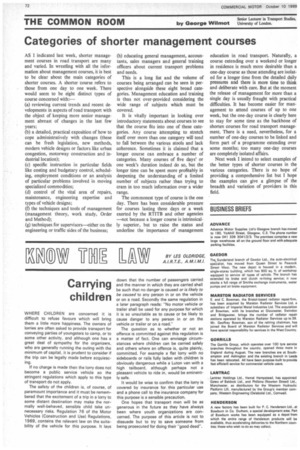BY LES OLDRIDGE,
Page 74

If you've noticed an error in this article please click here to report it so we can fix it.
Carrying children
WHERE CHILDREN are concerned it is difficult to refuse favours which will bring them a little more happiness. The owners of lorries are often asked to provide transport for conveying parties of youngsters to camp, or to some other activity, and although one has a great deal of sympathy for the organizers, who are generally running the outing with the minimum of capital, it is prudent to consider if the trip can be legally made before acquiescing.
If no charge is made then the lorry does not become a public service vehicle so the stringent regulations which apply to this type of transport do not apply.
The safety of the children is, of course, of paramount importance and it must be remembered that the excitement of a trip in a lorry to some distant destination may make the normally well-behaved, sensible child take unnecessary risks. Regulation 76 of the Motor Vehicles (Construction and Use) Regulations, 1969, contains the relevant law on the suitability of the vehicle for this purpose. It lays
down that the number of passengers carried and the manner in which they are carried shall be such that no danger is caused or is likely to be caused to any person in or on the vehicle or on a road. Secondly the same regulation in a later paragraph reads: "No motor vehicle or trailer shall be used for any purpose for which it is so unsuitable as to cause or be likely to cause danger to any person in or on the vehicle or trailer or on a road."
The question as to whether or not an offence is committed against this regulation is a matter of fact. One can envisage circumstances where children can be carried safely and others where an offence is, quite plainly, committed. For example a flat lorry with no sideboards or rails fully laden with children is obviously dangerous while a Luton van with a high tailboard, although perhaps not a pleasant vehicle to ride in, would be eminently safe.
It would be wise to confirm that the lorry is covered by insurance for this particular use and a phone call to the insurance company for this purpose is a sensible precaution.
One hopes that transport men will be as generous in the future as they have always been where youth organizations are concerned. The purpose of this article is not to dissuade but to try to save someone from being prosecuted for doing their "good deed".
























































































































